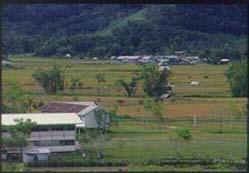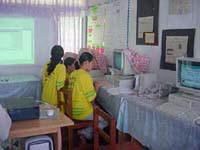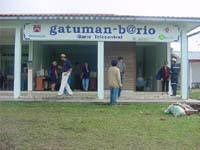|
Connecting Malaysia’s
rural communities to the Information Age:
The E-Bario project
Abstract
As a key component of
the Malaysian Government’s vision for modernization,
e-Bario is a development project that utilizes
computers, telephones, and VSATs to connect villagers
in the remote village of Bario to the Internet.
Sanctioned by the Government and administered
by a combination of public and private domestic and
international players, e-Bario demonstrates the many
ways in which ICTs can be used to help marginalized
communities in Malaysia develop socially, culturally
and economically.
Introduction
 One
of the most notable of Malaysia’s Internet
development initiatives is the e-Bario project.
Located in a remote village in eastern
Malaysia, Bario exemplifies the disconnected portion
of the digital divide.
For instance, while most of the district’s
1,000 inhabitants had heard of a computer, more than
90 per cent had never used one, let alone logged onto
the Internet. Conceptualized and inspired by a group of researchers seeking
to identify methods of connecting rural and isolated
communities to the Internet, e-Bario was designed to
determine how ICTs could help this remote district
develop socially, culturally and economically.
The project is being coordinated by the
Universiti of Malaysia Sarawak (UNIMAS), and
financially supported by Canada’s International
Development Research Centre (IDRC) and the Malaysian
Institute of Microelectronic Systems (MIMOS). The
overall objective of e-Bario is to make Sarawak,
Malaysia’s largest state on the island of Borneo, a
modern and competitive society, while using ICTs to
help stimulate human capacities within the community. One
of the most notable of Malaysia’s Internet
development initiatives is the e-Bario project.
Located in a remote village in eastern
Malaysia, Bario exemplifies the disconnected portion
of the digital divide.
For instance, while most of the district’s
1,000 inhabitants had heard of a computer, more than
90 per cent had never used one, let alone logged onto
the Internet. Conceptualized and inspired by a group of researchers seeking
to identify methods of connecting rural and isolated
communities to the Internet, e-Bario was designed to
determine how ICTs could help this remote district
develop socially, culturally and economically.
The project is being coordinated by the
Universiti of Malaysia Sarawak (UNIMAS), and
financially supported by Canada’s International
Development Research Centre (IDRC) and the Malaysian
Institute of Microelectronic Systems (MIMOS). The
overall objective of e-Bario is to make Sarawak,
Malaysia’s largest state on the island of Borneo, a
modern and competitive society, while using ICTs to
help stimulate human capacities within the community.
e-Bario was
designed to bridge the gap between the shy
and unexposed students in the village of Bario
and their aggressive, well-informed counterparts
in Malaysia’s larger cities. We hope e-Bario
will serve as the benchmark for future rural
development initiatives in Malaysia and
elsewhere in the developing world.” – Lucy
Bulan, Principal at a secondary school in Bario
|
Initially, two computer labs in local schools,
consisting of 10 PCs at a primary school and 12 PCs at
a secondary school, and a publicly accessible
telecenter with four computers, a printer and a fax
machine were created to connect the small village to
the global information network.
By systematically introducing computers into
society, project administrators hoped to improve
information flows to and from Bario, thus helping to
better the living conditions of the entire community.
Connected via four VSATs provided by Telekom Malaysia
powered by diesel fuel and solar power, e-Bario has
allowed thousands of Malaysians to learn how to use
ICTs to better their socio-economic position.
Additionally, to help the villagers communicate
and share information with family and friends outside
of Bario, Telekom Malaysia also installed six public
payphones throughout the district.
Background
 As
part of the Government’s “k-economy” initiative,
which seeks to move Malaysians away from physical
resources and toward knowledge-based resources, the
project organizers sought to identify a remote,
isolated district to conduct a pilot project to
determine effective methods for connecting rural
communities to the Internet.
Bario met all of the experiment’s
qualifications for the pilot project, and presented a
challenging environment in which to test the idea of
rural Internet connectivity in Malaysia.
Initially, a base line study was conducted to
help the project administrators gain an understanding
of the cultural, social, information and economic
dynamics of Bario. Not only did the initial research demonstrate that the
residents were hungry for new information resources,
but it suggested that the majority of teachers and
students were well prepared for ICT adoption.
For instance, the IDRC found that each of the
13 secondary school teachers already polled had an
intermediate to advanced level of IT understanding.
An IT literacy program has been established to
help expand their knowledge of how to use computers
and the Internet. As
part of the Government’s “k-economy” initiative,
which seeks to move Malaysians away from physical
resources and toward knowledge-based resources, the
project organizers sought to identify a remote,
isolated district to conduct a pilot project to
determine effective methods for connecting rural
communities to the Internet.
Bario met all of the experiment’s
qualifications for the pilot project, and presented a
challenging environment in which to test the idea of
rural Internet connectivity in Malaysia.
Initially, a base line study was conducted to
help the project administrators gain an understanding
of the cultural, social, information and economic
dynamics of Bario. Not only did the initial research demonstrate that the
residents were hungry for new information resources,
but it suggested that the majority of teachers and
students were well prepared for ICT adoption.
For instance, the IDRC found that each of the
13 secondary school teachers already polled had an
intermediate to advanced level of IT understanding.
An IT literacy program has been established to
help expand their knowledge of how to use computers
and the Internet.
Realizing the importance of community engagement and
empowerment, the e-Bario project was designed around a
participatory development model from the beginning.
While the project was inspired by researchers
outside of Bario, throughout the implementation
process community leaders have consistently provided
input to its evolution.
Given their understanding of social and
cultural dynamics, the community leaders have also
been actively involved in identifying ways to sustain
the project once UNIMAS and IDRC withdraws.
The e-Bario project clearly demonstrates the
effectiveness of how the public and private sectors
can work together to sensitize rural communities to
the capabilities and uses of new technologies, and the
many ways in which ICTs can improve the lives of
marginalized groups.
Conclusions
 E-Bario
highlights the various components of creating a
sustainable ICT-focused development programme.
For instance, the project demonstrated that
ICTs cannot just be “dropped” in a rural village,
but need to be accompanied by training and education
to be successful and sustainable.
Projects such as e-Bario are designed to help
the Government close the rural-urban digital divide
and achieve its objective of connecting 25 per cent of
the population to the Internet by 2005.
Despite the imminent success of e-Bario, such
grassroots ICT development initiatives remain largely
experimental, as the long-term effects on a given
society are not readily apparent.
However, it is obvious from the first three
years of the project that a participatory approach is
a prerequisite for sustainability. E-Bario
highlights the various components of creating a
sustainable ICT-focused development programme.
For instance, the project demonstrated that
ICTs cannot just be “dropped” in a rural village,
but need to be accompanied by training and education
to be successful and sustainable.
Projects such as e-Bario are designed to help
the Government close the rural-urban digital divide
and achieve its objective of connecting 25 per cent of
the population to the Internet by 2005.
Despite the imminent success of e-Bario, such
grassroots ICT development initiatives remain largely
experimental, as the long-term effects on a given
society are not readily apparent.
However, it is obvious from the first three
years of the project that a participatory approach is
a prerequisite for sustainability.
While the Government
played an indirect role in conceptualizing e-Bario, it
was instrumental in creating the necessary enabling
environment for the project’s implementation.
By helping the project administrators fully
understand its national modernization vision, the
Government played an important role in helping the
community of Bario realize their potential to reshape
their environment and become a knowledge-based
society. Given that rural Internet connectivity is a
central component to the government’s overall
Internet development objectives, e-Bario will probably
become a benchmark for how ICTs can improve the lives
of rural Malaysians.
For additional
information on the e-Bario project visit the following
links:
|